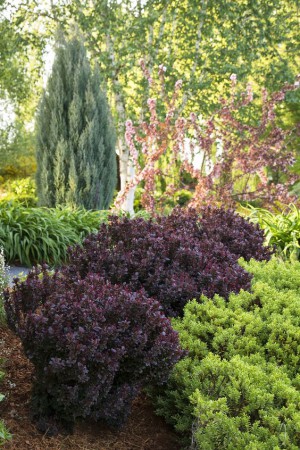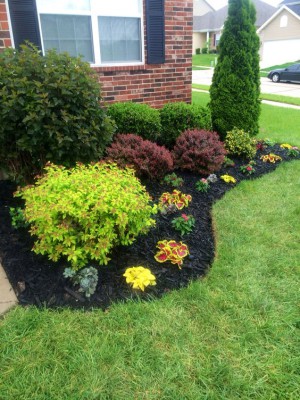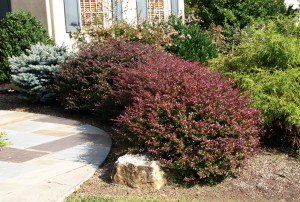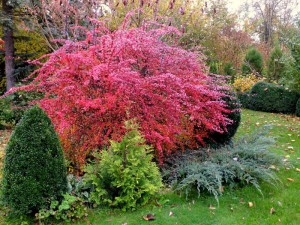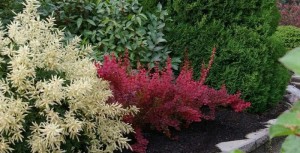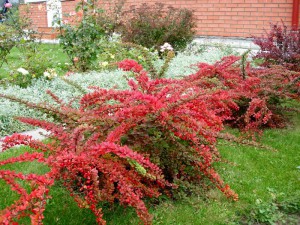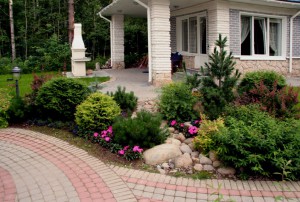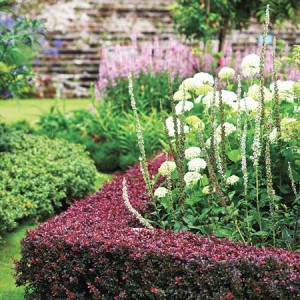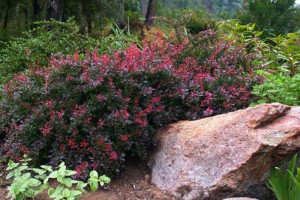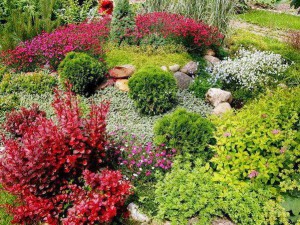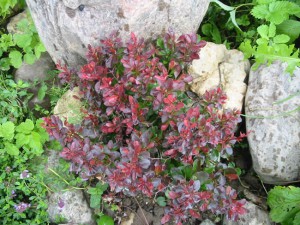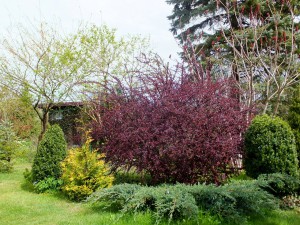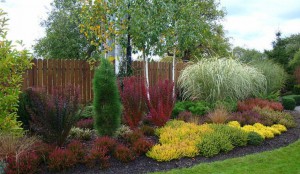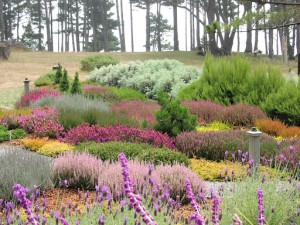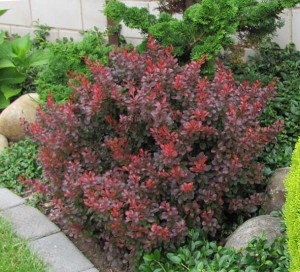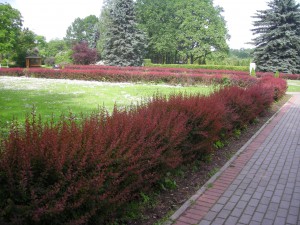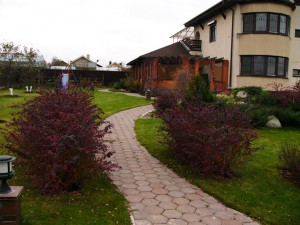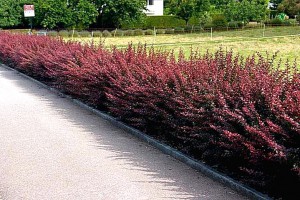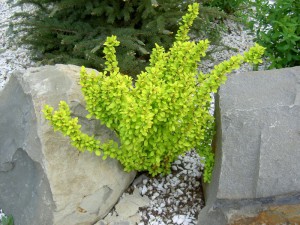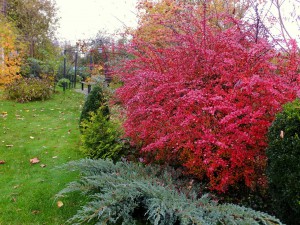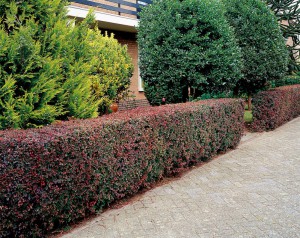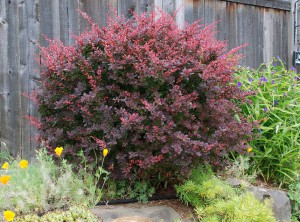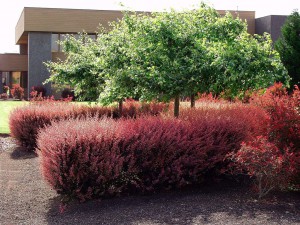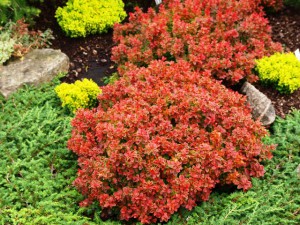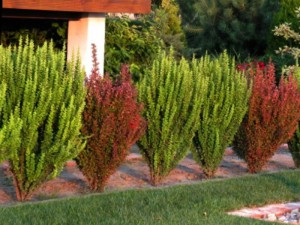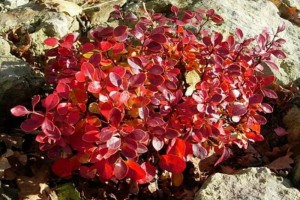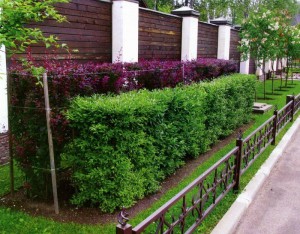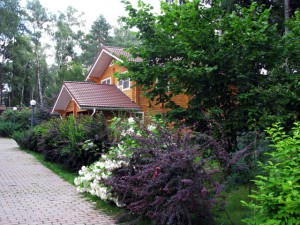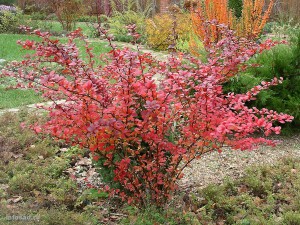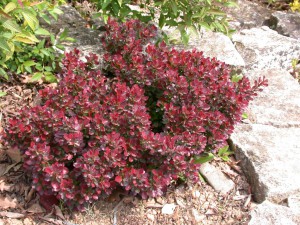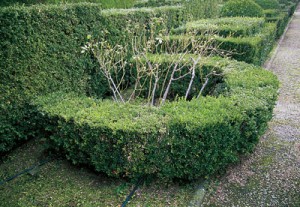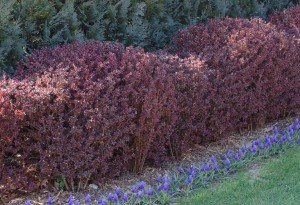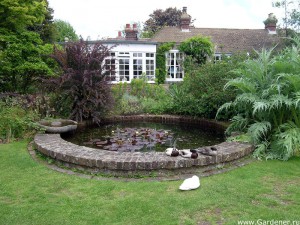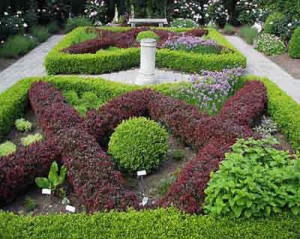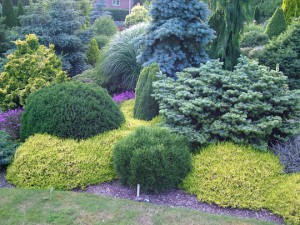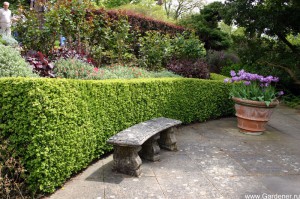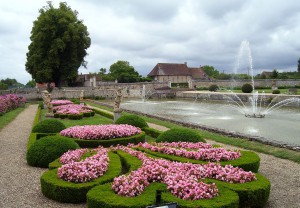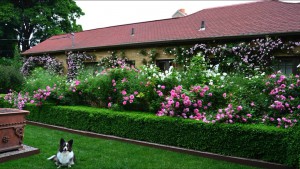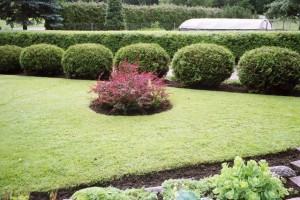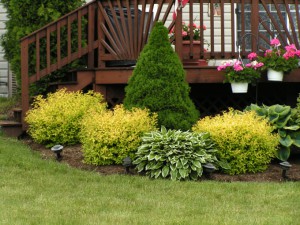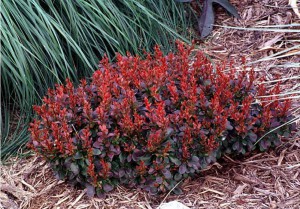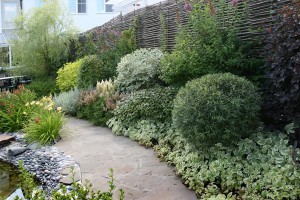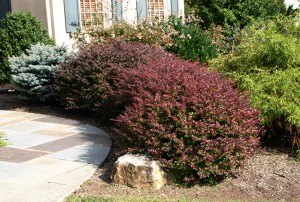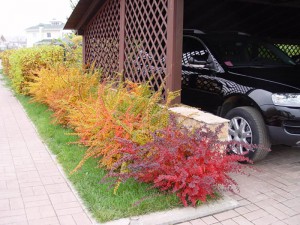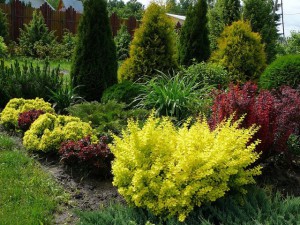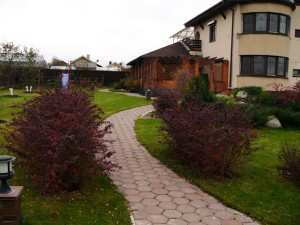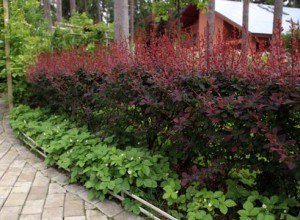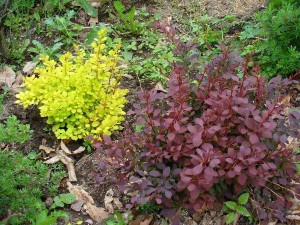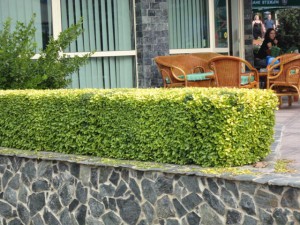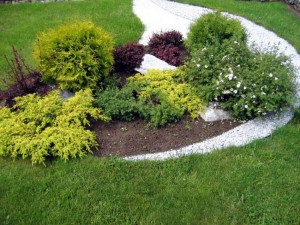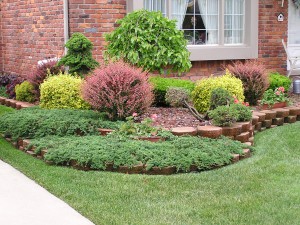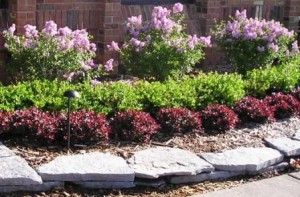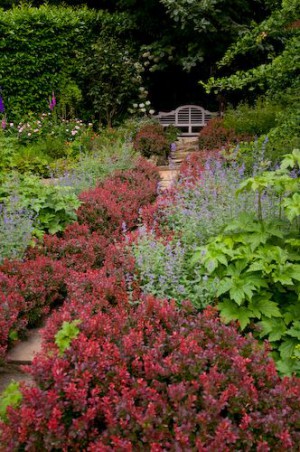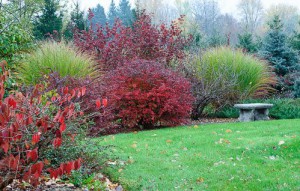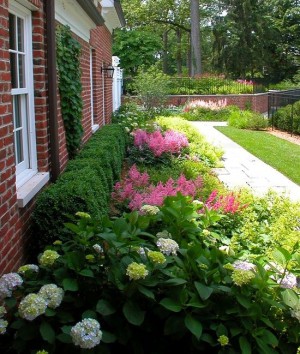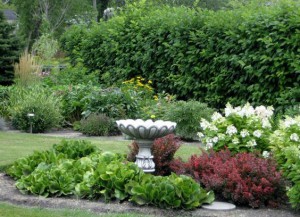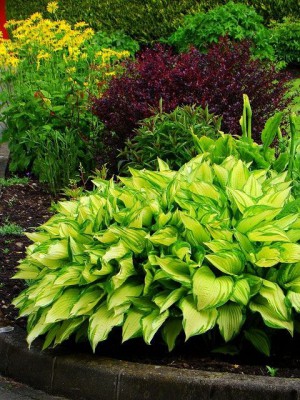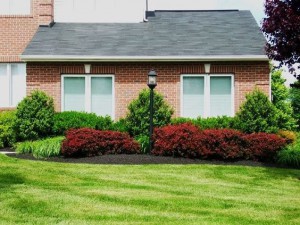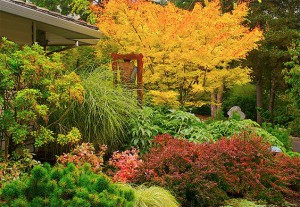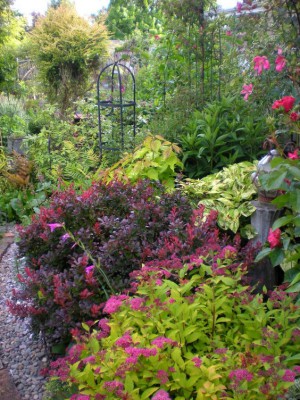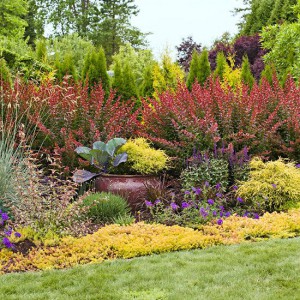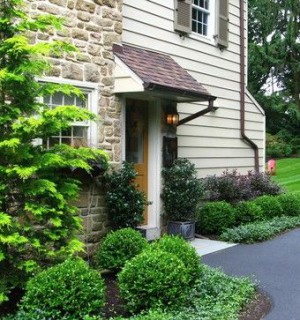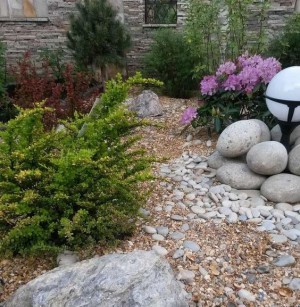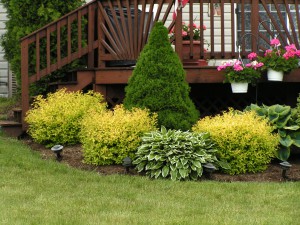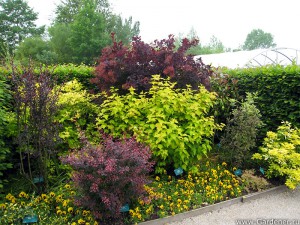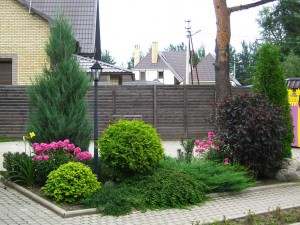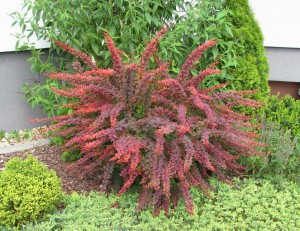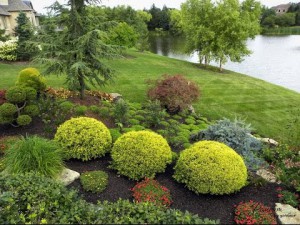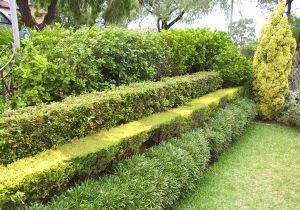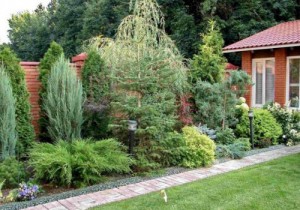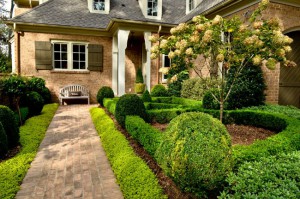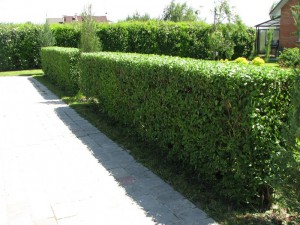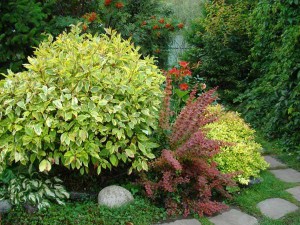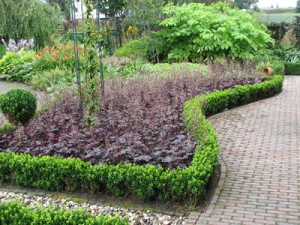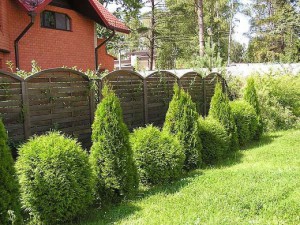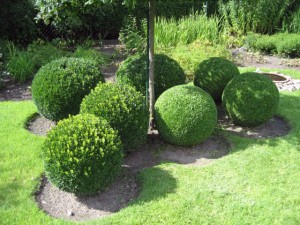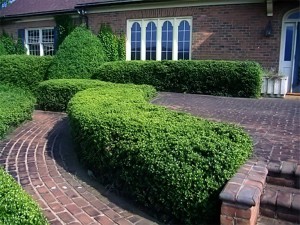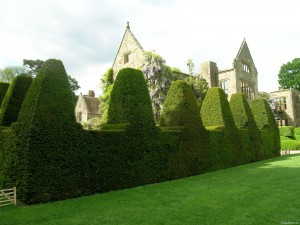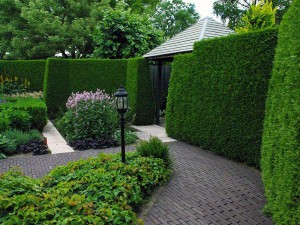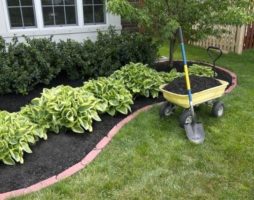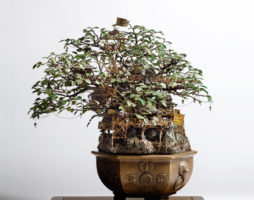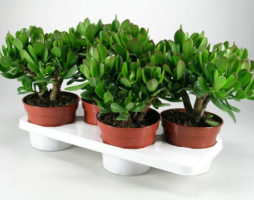Barberry is one of the brightest representatives of unpretentious and long-lived shrubs that can not only bring delicious fruits, but also take part in the landscape design of a suburban area.
They are distinguished by straight prickly branches. In some varieties, the spikes grow to a centimeter size. In a young plant, the branches are thin and the bush has a loose constitution, but in just a couple of years it will grow and “stiffen” so much that it will become an absolutely impenetrable barrier.

Sheared barberry bushes will decorate the site
An adult barberry can reach a height of three meters, however, there are varieties in the group that do not grow above 30. The shrub is easy to cut and this made it not only the best choice for hedges, but also for the embodiment of topiary ideas.

hedge of barberry bushes
Barberry in landscape design
Barberry bushes are the best way to decorate:
1. Framing lawns.
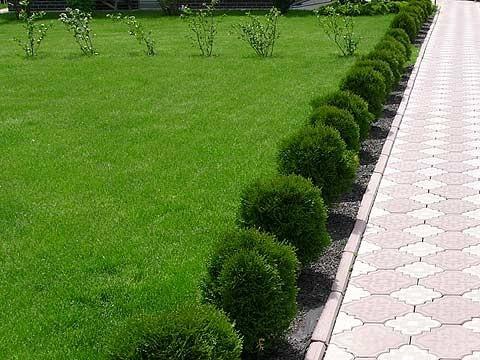
Low bushes of barberry frame the lawn
2. Japanese gardens.
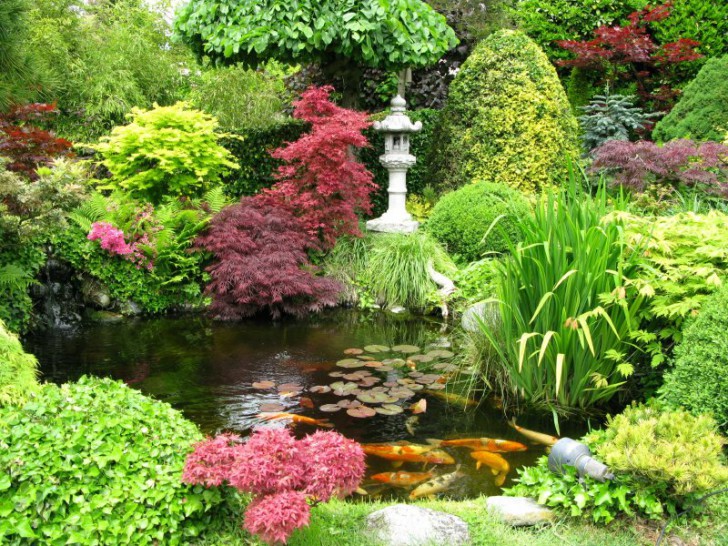
Bright barberry bushes will organically fit into the composition of the Japanese garden
3. Hedgerows.
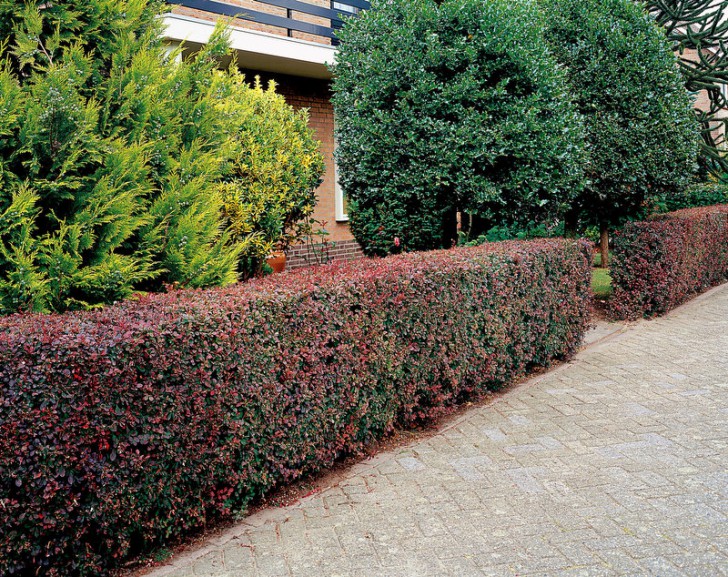
Barberry hedge
4. Alpine slides.
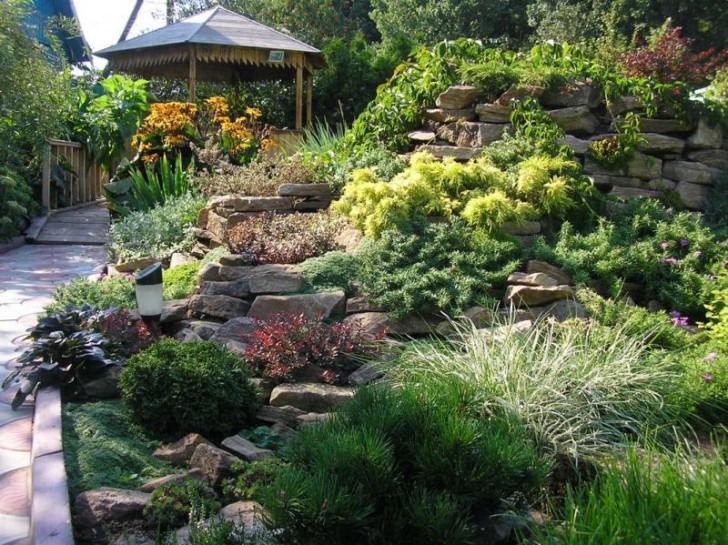
Low varieties of barberry are suitable for making alpine slides
This is largely facilitated by the extensive color palette of the plant. Barberry can be yellow-red, purple-blue or red-green. By combining the color varieties of barberry with other types of shrubs, you can get simply luxurious compositions. Barberry can act in this case both as the main background and as an accent zone.
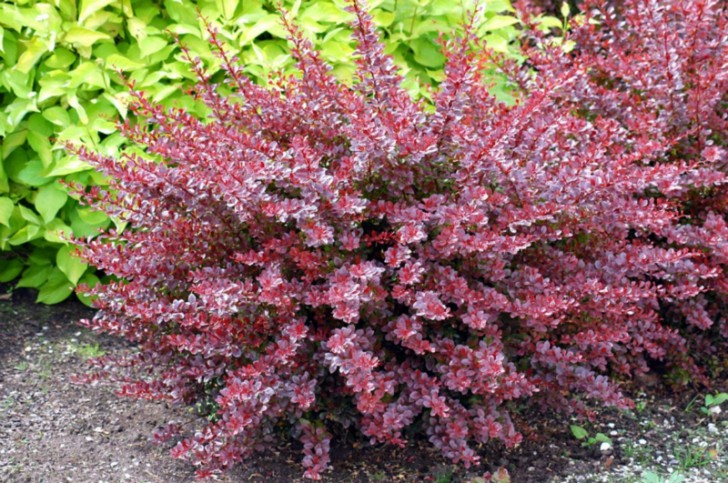
Bright purple barberry for the accent zone
Dwarf varieties are used to decorate the perimeter of flower beds. The shrub will do an excellent job of protecting flowers and grass growing on them from trampling. Sometimes the owners enclose the holes around the trees with a barberry hedge. It turns out a very picturesque picture.
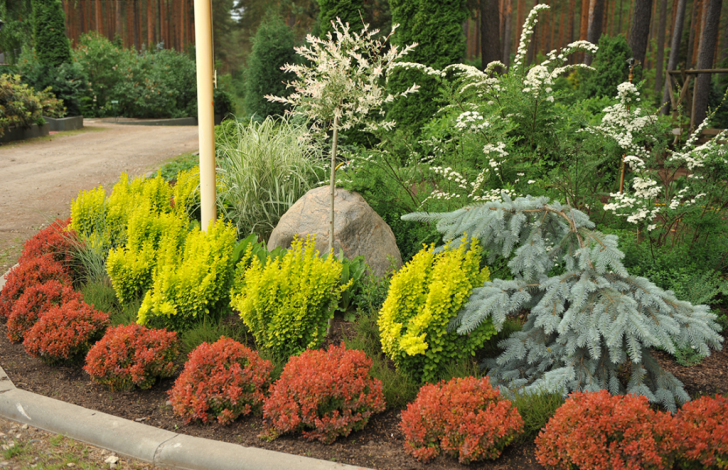
Dwarf barberry can be planted around the perimeter of the flower bed
When planting a barberry with a hedge, you can take care of it in different ways. Someone prefers to leave the bushes in their original form, while others are impressed by beautifully trimmed "fences". Barberries with erect branches are best able to keep their shape. It is not difficult for them to form rounded compositions.
back to index ↑Rules for planting barberry
The most important thing when planting a barberry bush is not to plant it near groundwater. The plant does not tolerate excess moisture, so seedlings are not planted in the lowlands. Land for planting should be well drained and, of course, fertile. If your site has excessively acidic soil, then it will have to be limed, moreover, a little sand will need to be added to each prepared planting hole. This will increase aeration.
Dislikes barberry and dense shade. In such an environment, the bush will lose its unusual color and will not bear fruit, so take the plant to a well-lit area.

Barberry is best planted in a well-lit area.
When growing any plant, some effort is required, and the barberry, for all its unpretentiousness, will not be an exception. There will be no special requirements, but some points are also important for him.
back to index ↑How to get a seedling
“It is better for a beginner gardener to buy a strong seedling, because fussing with seeds will take a lot of time, and may not give the expected results”
Cuttings and seeds are suitable for obtaining a seedling. You can propagate bushes by division and layering. It is better for a novice gardener to buy a strong seedling, because fussing with seeds will take a lot of time, and may not give the expected results.

It is better for novice gardeners to purchase ready-made barberry seedlings.
For propagation with a cutting, the desired part of the bush is carefully cut off and planted in the ground or a pot. Further planting will need to be watered regularly, and wait for the roots to appear. If the seedling grew in a flowerpot, then, transferring it to open ground, you should not pick it out of the potting soil, so as not to damage the fragile roots. For propagation by layering, the shoot must be pinned and sprinkled with earth. The soil in this place is moistened, stimulating layering to release horses.
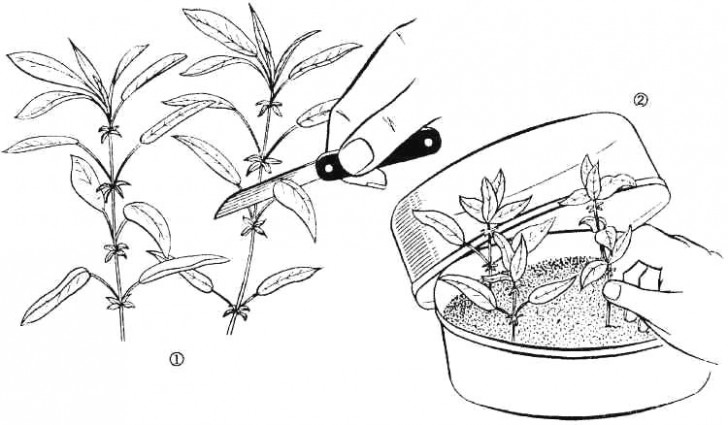
Propagation of barberry cuttings
The most convenient way to breed barberry thickets is to divide the bush. The plant is dug up and divided into parts. Each newly formed bush is returned to the ground. Barberry easily tolerates this procedure, takes root well and quickly begins to bear fruit.
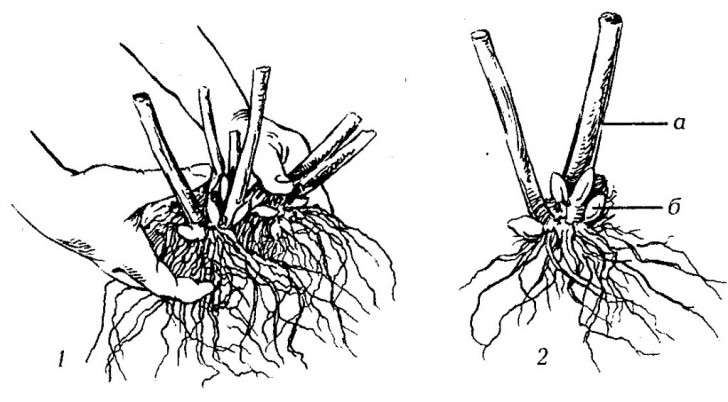
The division of the barberry bush
The plant is not particularly demanding on soils, but to the place - yes. It should be planted in the sun, in extreme cases - in partial shade. A single bush is preparing a landing pit with a volume of half a cubic meter. For a hedge, it is more profitable to dig a trench, not a hole. Drainage is arranged in a prepared place, the soil is well moistened and fertilizers are mixed into it.
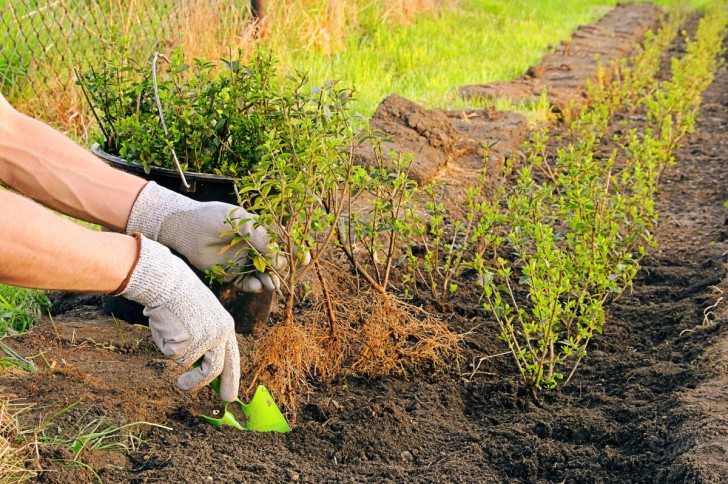
Before planting a barberry hedge, it is necessary to dig a trench
Suitable:
1. Peat.
2. Humus.
3. Superphosphate.
For drainage, you can take:
1. sawdust.
2. Rubble.
3. Leaves.
After all these procedures, the landing site can be considered ready.
back to index ↑When to plant
Planting time will depend on the type of seedling and its type. So, a seedling with an open root system is transferred to the ground in early spring, while the buds are sleeping. In this case, the bush will quickly take root and will not be stunted afterwards. You can plant barberry in the fall, in September. The bush will have enough time before the cold weather to take root.
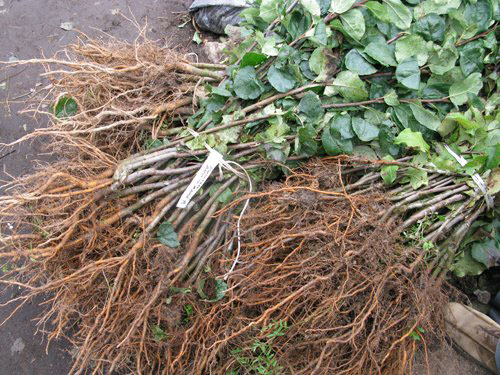
Seedlings with an open root system
Plants from containers are planted without regard to such nuances, the main thing here is not to do this in the heat. Yes, and after planting the first time, the seedlings will have to be covered from the sun's rays.
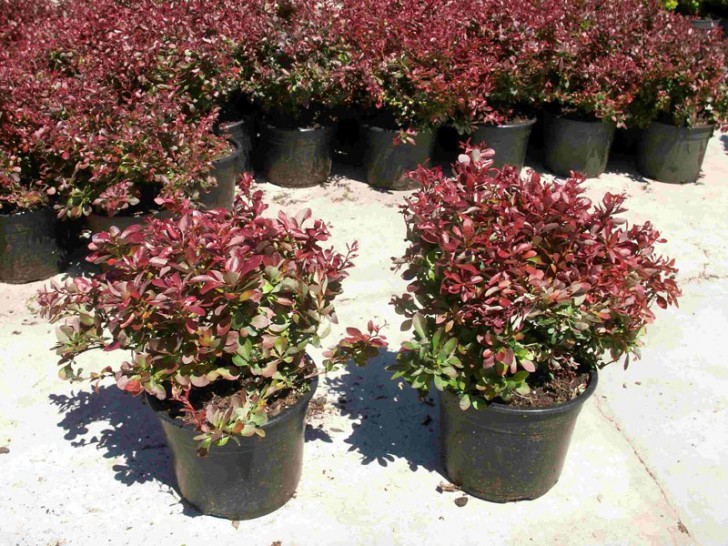
Barberry seedlings in containers
top dressing
Fertilization of bushes such as barberry is required every few years. Experts say that this is quite enough to stimulate the plant and make it feel great. If you are going to feed the plants in the spring, then you will need nitrogen fertilizers.
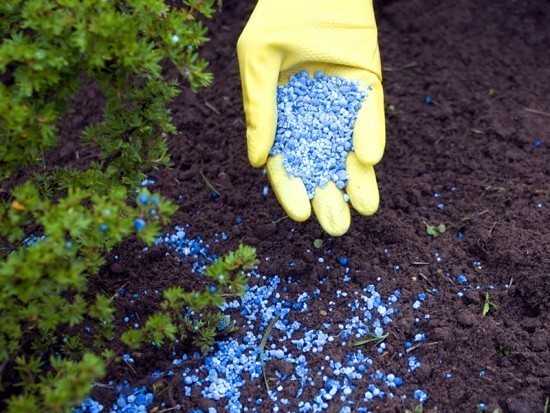
In early spring, the barberry is fed with nitrogenous fertilizers.
Autumn is more suitable for organics and phosphate-potassium substances.
back to index ↑Care rules
Barberry refers to plants that do not need any care at all, and after a properly organized planting, in general, in principle, you can forget about it. However, if you want to get a truly decorative and abundantly fruiting shrub, then you still have to deal with barberry.
In the second year of life, the plant needs to be fed. He will need potash and nitrogen fertilizers in spring and superphosphate top dressing - closer to autumn.

In autumn, the barberry is fed with superphosphate fertilizers.
Barberry is a fast-growing shrub, so it needs regular pruning.You will have to remove the thickening bushes of the central branches. Although the plant is classified as frost-resistant, nevertheless, in our harsh conditions it may not survive. In this case, in the spring, you will also have to remove frost-damaged branches. In order to prevent damage to the shrub, the first years it is covered with burlap for the winter.
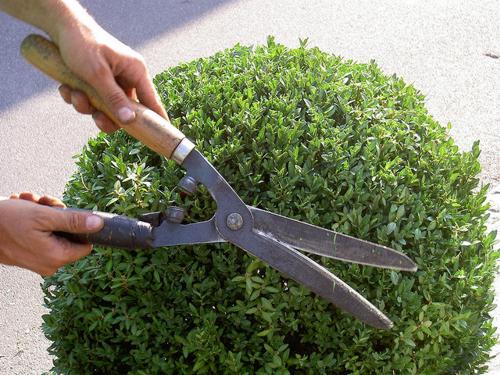
Barberry needs regular pruning
Like any living plant, barberry is also subject to attack by pests and diseases. If such problems arise, appropriate treatment should be carried out. Strongly affected areas are best worked out radically, that is, cut out diseased branches and burn them. Do not worry, even after a seemingly extremely hard pruning, the bush will quickly restore its splendor. From aphids and flower moths, barberry is saved with 0.2% phytoverm, powdery mildew is removed with foundationazole, and such a nuisance as rust is eliminated with 1% Bordeaux liquid.
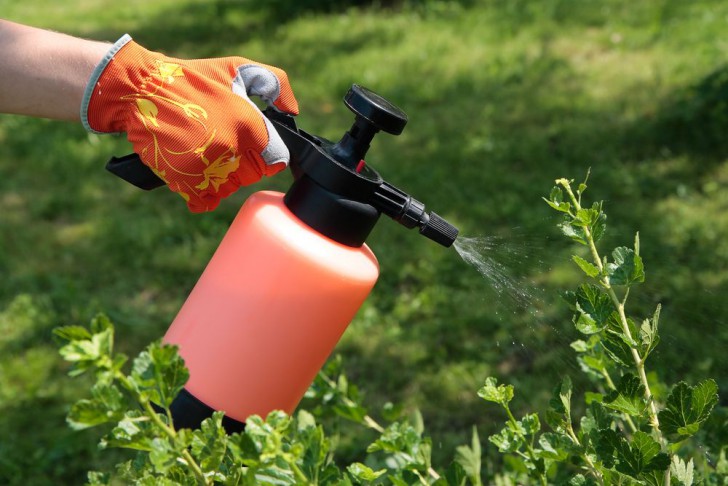
When pests appear, the bushes must be processed
There are several nuances in growing barberries that you need to know about:
- Collection varieties should be covered for the winter.
- Barberry is a honey plant, and, therefore, has a pronounced aroma, so there is no need to allocate an area near the house for its planting.
- Work with shrubs should be in durable gloves. His spikes can seriously injure.
- Watering the plants is carried out only during periods of prolonged drought. This is done no more than three times a week.
- Dried branches should be removed immediately.
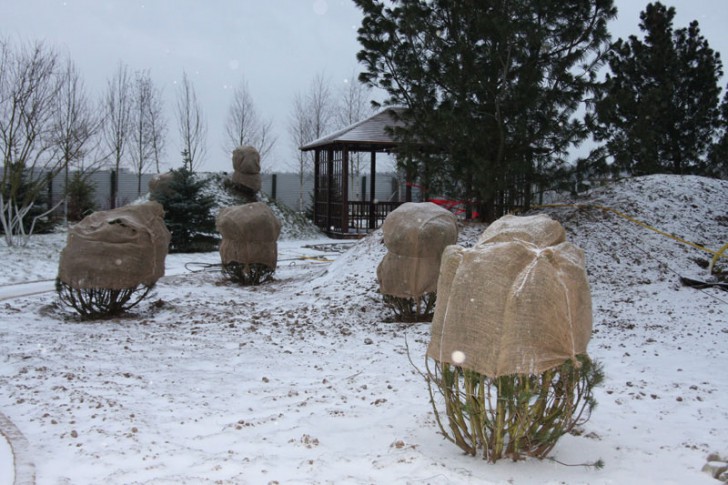
Rare varieties of barberry shelter for the winter
Autumn work
At this time, it is good to transplant ready-made seedlings to a place of permanent growth. It is necessary to dig up the soil near the bushes and remove plant debris from them. If the time has come, then the plants are fed with compost and humus. Also, before winter, the planting is checked for the presence of diseased branches and removed.
Barberry pruning rules
Plant pruning is:
1. Sanitary.
2. Decorative.
Sanitary cleaning is carried out regularly. Its goal is to rid the bush of diseased, dry, thinned branches, as well as simply thinning the crown of the plant in case of excessive thickening. Care should be taken to ensure that new shoots grow long and powerful, this will affect the strength of flowering and affect fruiting.
If pruning was done due to any disease, then all removed parts (affected shoots, leaves) must be burned.
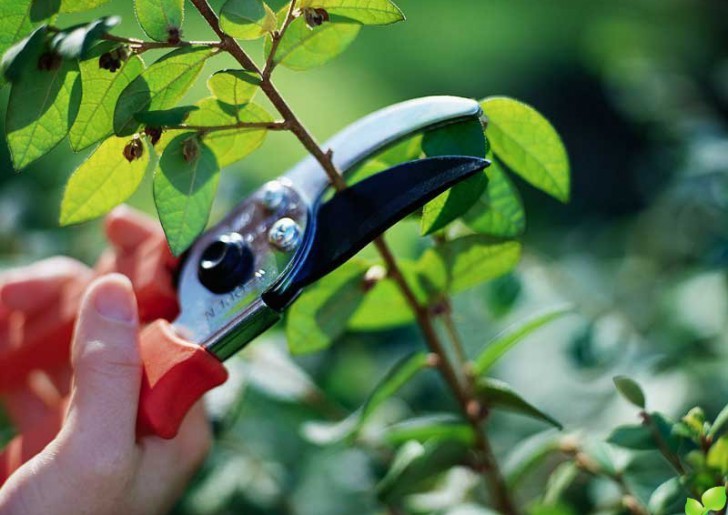
During sanitary pruning, the affected parts of the barberry are burned
Decorative pruning is done on healthy lush bushes. They are given the appearance of various figures and even sculptural compositions.
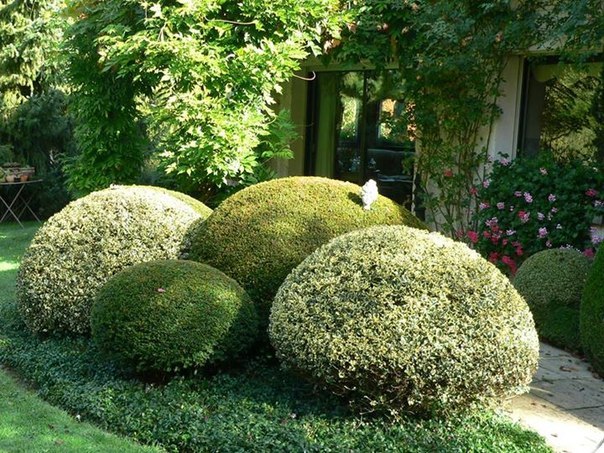
With decorative pruning, barberry bushes can be given any shape
Features of the formation of a bush
The crown of the barberry itself folds perfectly, so you just need to adjust the number of branches in it. The number of shoots left will depend on the purpose of growing the plant. If this is a rich harvest, then thickening should be fought more actively, many berries will not be born in the thickets. If the bush has an exclusively decorative load, then it should be formed more powerfully. For a hedge, for example, the number of branches left will be in the tens, depending on the dimensions of the hedge.
Basics of decorative haircuts
Barberry is the only one of the shrub family that can retain its spectacular shape for a long time after cutting; moreover, it is suitable for creating the most complex curly profiles. This became possible due to the huge varietal number of plants. The presence of multi-colored foliage gives designers a chance to create colorful and picturesque garden compositions from them. It is noteworthy that it is permissible to cut the barberry at any time, the bushes easily tolerate the shortening of one- and two-year-old shoots. Regular trimming will keep your hedges looking fresh and tidy. She will always look neat.In addition, frequent pruning will contribute to the growth of the crown, stimulate the growth of lateral branches and leaves on them.
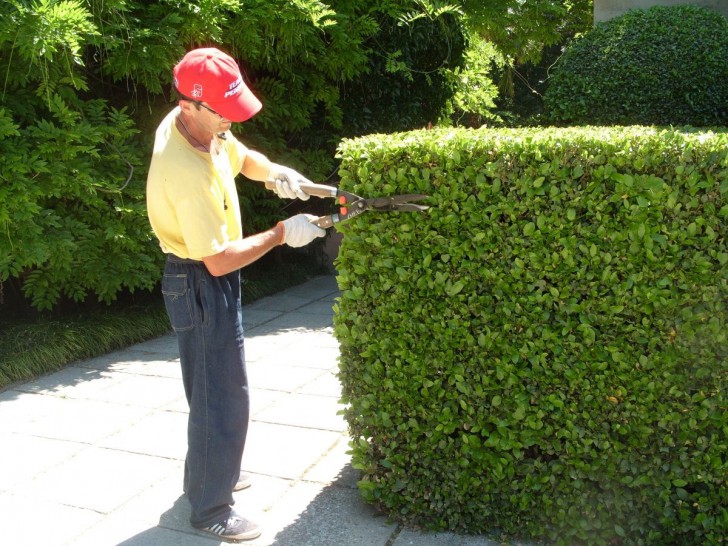
Dense barberry hedge
Young, newly planted hedges are cut only once for the first two years. A gentle haircut is timed to coincide with the beginning of spring or the end of autumn. Over the years, the number of haircuts can increase up to 3 times a year.
Haircut is a step by step process.
The first step is to trim the plants. Bushes, the crown of which is poorly formed, are cut in half; in mature plants, the branches are cut in a third. The time of the first pruning is the next season after planting in the ground, that is, the bushes planted in the spring are cut off in the fall.
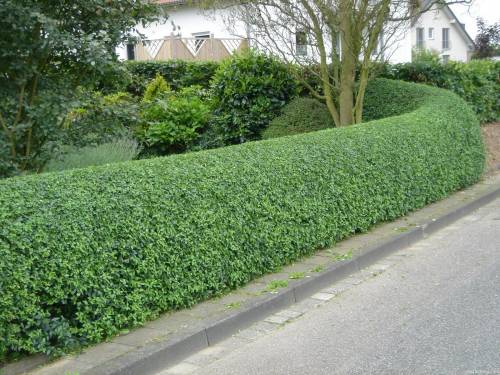
The first cutting of bushes is done in autumn
The second stage is the actual formation of the fence. Its purpose is to give the bushes a certain profile and thicken the crown. Turning the barberry into a hedge, they tend to give the bushes a rectangular shape with regular cuts and flat tops and sides. This will only work when the height of the fence is made greater than the width. Otherwise, the lower shoots will suffer from a lack of light. They will get naked and die.
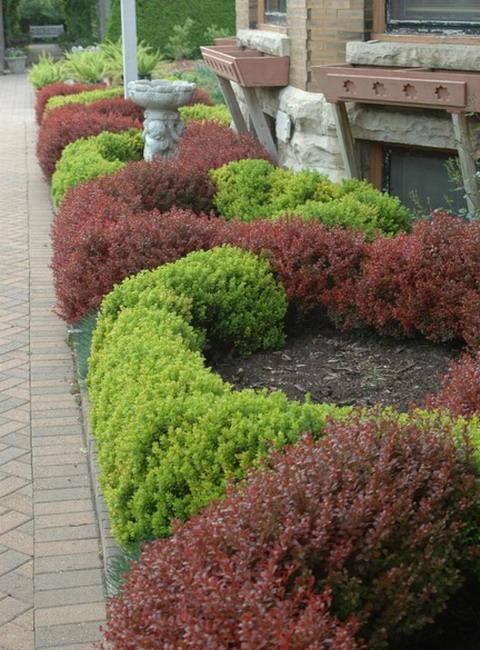
Living fence of two types of barberry
The shrub can be cut in a round shape. It is often given a trapezoidal profile with an expanded base. In these cases, all shoots will have the opportunity to develop in conditions of sufficient illumination, which means that the hedge will seem well-groomed and beautiful.
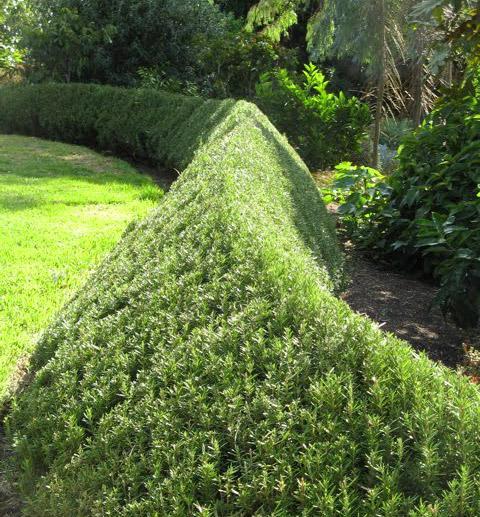
Trapezoidal pruning of barberry will allow all shoots to develop well
If over the years the bushes lose their former attractiveness, then they need to be rejuvenated.
Barberry rejuvenation
“Barberry is revered by landscape designers both for its responsiveness to pruning and for its eternal off-season decorativeness”
When aging, barberry bushes need anti-aging procedures. They can be done in different ways. There is an option for specific pruning, the task of which is to transfer the load to a more powerful shoot located near the base of the branch, or to cut out the entire old branch, and instead form a new growth.
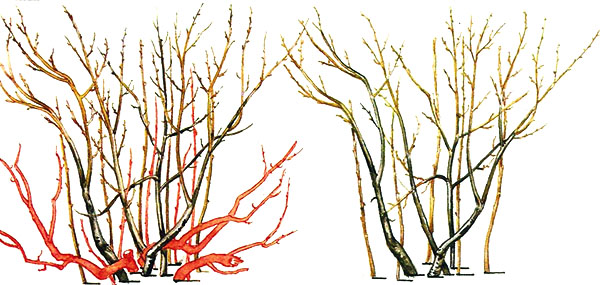
Pruning scheme for rejuvenation of a barberry bush
It is necessary to engage in rejuvenation in the spring, before the opening of the kidneys. Work carefully, especially if you want to see your bush bloom and bear fruit. The good tolerance of barberry trimming is not a reason to shred it mercilessly. Remember that only one-year-old shoots are capable of blooming and bearing fruit in barberry.
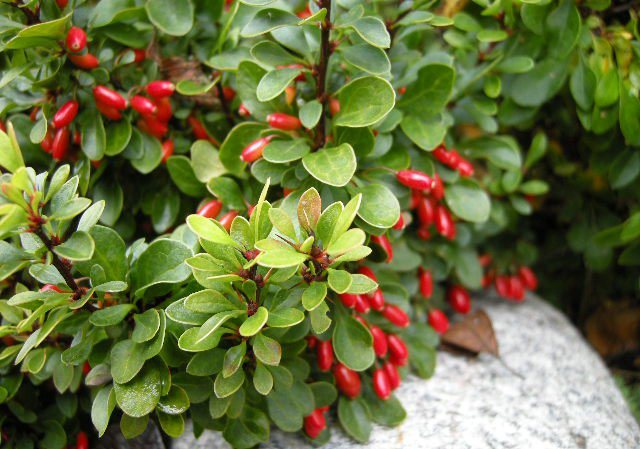
barberry fruits
Barberry is revered by landscape designers both for its responsiveness to pruning and for its eternal off-season decorative effect. If everything is done correctly, the bushes will delight you with their picturesqueness all year round. By May, they will be covered with small flowers formed into clusters, and in summer they will delight the eye with juicy greens of glossy foliage. In autumn, the barberry will change the green color of the crown to crimson and delight with bright clusters of berries that will hang on it until spring. Just imagine how picturesque such a fence would be framed by snow cover.
Tools
In order to non-traumatically process a barberry bush, you need to have the appropriate tools. For cutting young shoots, it is better to use a hand tool. Regular pruners and garden shears will do. After their use, there are practically no damaged leaves on the branches, which will turn yellow and fall off over time, and the haircut itself can be done with maximum accuracy and thoroughness.
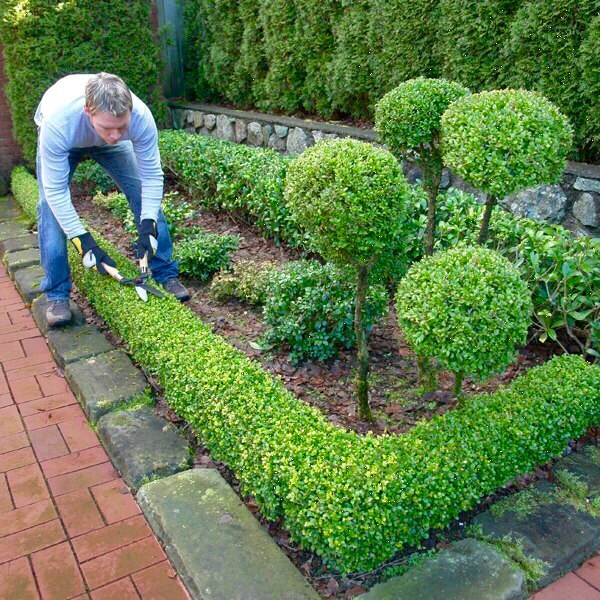
Shearing barberry with garden shears
In more mature plants, the crowns are trimmed with brush cutters, chainsaws, and electric scissors. It is important, when preparing a power tool for work, to check the quality of sharpening of cutting elements. Well, the right angle sharpened blades will save you from the appearance of branches with split ends.
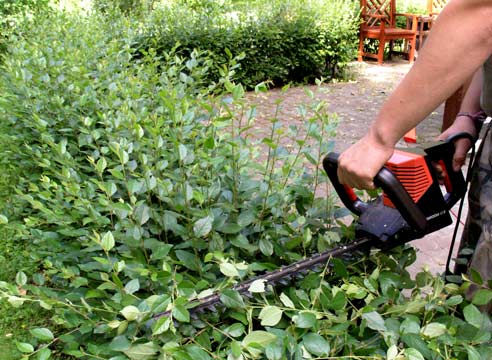
An electric hedge trimmer is suitable for cutting more mature plants.
To make the fence line even, you can resort to all kinds of auxiliary devices. For example, it is convenient to cut the edges along a stretched cord. To form a hedge, you can use a brightly colored wire frame. It is put on over the bushes and cut off all the shoots that protrude beyond its borders.
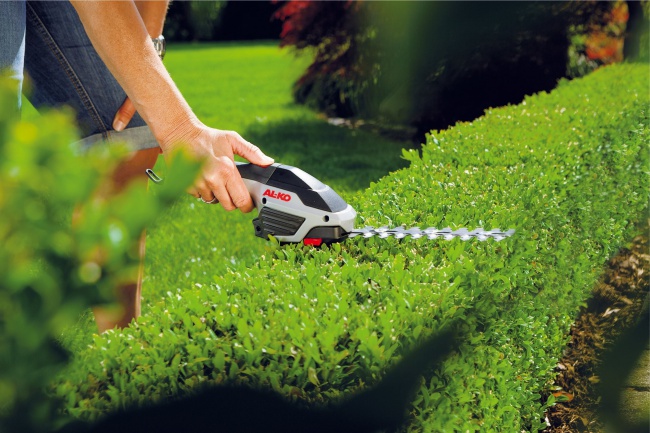
For even cutting bushes, you can pull the cord
Conclusion
Such a highly decorative plant as barberry will give your site originality and make it look unusually aesthetic, and, as you understand, without much effort on your part, so if you still have not acquired such a miracle in the local area, then it's time to do it.
Photo gallery - barberry
Video
